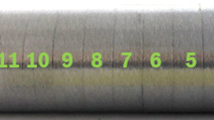Abstract
Successful grinding of a final product depends upon a large number of parameters that affect the grinding result and are strongly interlinked. It is, therefore, difficult to detect directly the generation of grinding faults such as chatter vibration and burning. In this paper, to achieve the development of an intelligent diagnostic technique for chatter vibration and burning phenomena on grinding process, acoustic emission signals were processed and signal parameters of the acoustic emission were also determined. In addition, a neural network was used as a diagnostic technique of the grinding state. A momentum coefficient, learning rate, and structure of the hidden layer were determined during the iterative learning process and the performance of the diagnostic technique was evaluated.










Similar content being viewed by others
References
Kim GH, Inasaki I, Lee JK (1994) Architecture of knowledge-base and management system for grinding operations. J KSPE 11(1):211–218
Kawamura S, Mitsuhashi M (1981) Studies on the fundamentals of grinding burn (3rd report)—oxidation rate raw of workpiece. J JSPE 47(9):106–111
Liao YS, Shiang LS (1991) Computer simulation of self-excited and forced vibrations in the external cylindrical plunge grinding process. Trans ASME 113(8):297–304
Inasaki I (1999) Sensor fusion for monitoring and controlling grinding processes. Int J Adv Manuf Tech 15(10):730–736
Tonshoff HK, Karpuschewski B, Regent C (1999) Process Monitoring in Grinding Using Micro-magnetic Technique. Int J Adv Manuf Tech 15(10):694–698
Malkin S (1989) Grinding technology-theory and applications of machining with abrasives. Wiley, New York, pp 74–92
Konic W, Altintas Y, Memis F (1995) Direct adaptive control of plunge grinding process using acoustic emission sensor. Int J Mach Tool Manuf 35(10):1445–1457
Wakuda M, Inasaki I, Ogawa K, Takahara M (1993) Monitoring of the grinding process with an AE sensor integrated CBN wheel. J JSPE 59(2):97–102
Dornfeld D, Cai HG (1984) An investigation of grinding and wheel loading using acoustic emission. Trans ASME 106(2):28–33
Emel E, Asibu EK (1988) Tool failure monitoring in turning by patterning recognition analysis of AE signals. Trans ASME 110(5):137–145
Freeman JA, Skapura DM (1991) Neural networks-algorithms, applications, and programming techniques. Addison-Wesley, New York, pp 60–104
Tandon V, Ei-Mounayri H (2001) A novel artificial neural networks force model for end milling. Int J Adv Manuf Tech 18(10):693–700
Author information
Authors and Affiliations
Corresponding author
Rights and permissions
About this article
Cite this article
Kwak, JS., Ha, MK. Intelligent diagnostic technique of machining state for grinding. Int J Adv Manuf Technol 23, 436–443 (2004). https://doi.org/10.1007/s00170-003-1899-0
Received:
Accepted:
Published:
Issue Date:
DOI: https://doi.org/10.1007/s00170-003-1899-0




